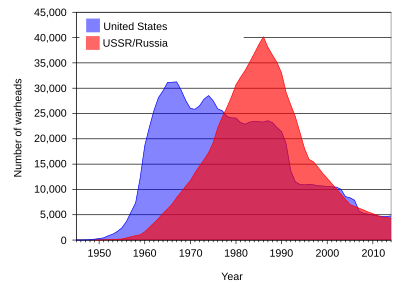Arms race
This article needs additional citations for verification. (June 2007) |

An arms race occurs when two or more groups compete in military superiority.[1] It consists of a competition between two or more states to have superior armed forces, concerning production of weapons, the growth of a military, and the aim of superior military technology.[2] Unlike a sporting race, which constitutes a specific event with winning interpretable as the outcome of a singular project, arms races constitute spiralling systems of on-going and potentially open-ended behavior.[3]
The existing scholarly literature is divided as to whether arms races correlate with war.[4] International-relations scholars explain arms races in terms of the security dilemma, engineering spiral models, states with revisionist aims, and deterrence models.[4][5][6]
Examples


From 1897 to 1914, a naval arms race between the United Kingdom and Germany took place.[4][7] British concern about rapid increase in German naval power resulted in a costly building competition of Dreadnought-class ships. This tense arms race lasted until 1914, when the war broke out. After the war, a new arms race developed among the victorious Allies, which was temporarily ended by the Washington Naval Treaty.
In addition to the British and Germans, contemporaneous but smaller naval arms races also broke out between Russia and the Ottoman Empire; the Ottomans and Greece; France and Italy; the United States and Japan in the 1930s;[4] and Brazil, Argentina, and Chile.
Nuclear arms race

This contest of the advancement of offensive nuclear capabilities occurred during the
Charles Glaser argues that numerous cases of arms races were suboptimal, as they entailed a waste of resources, damaged political relations, increased the probability of war, and hindered states in accomplishing their goals. However, arms races can be optimal for security-seeking states in situations when the offense-defense balance favors offense, when a declining state faces a rising adversary, and when advances in technology make existing weapons obsolete for the power that had an advantage in the existing weaponry.[4]
Artificial intelligence arms race
An example which has emerged in recent years is the one of an artificial intelligence arms race. A military artificial intelligence arms race is an arms race between two or more states to develop and deploy
Other uses
An
In technology, there are close analogues to the arms races between parasites and hosts, such as the arms race between writers of
More generically, the term is used to describe any competition where there is no absolute goal, only the relative goal of staying ahead of the other competitors in rank or knowledge. An arms race may also imply futility as the competitors spend a great deal of time and money, yet with neither side gaining an advantage over the other.
See also
- Nuclear arms race
- Arms control
- Arms industry
- Cyber arms race
- Driver safety arms race
- AI arms race
- Lewis Fry Richardson for his mathematical analysis of war
- Second Cold War
- Military–industrial complex
- Missile gap
- One-upmanship
- Revolution in military affairs
- Security dilemma
- Space race
- Weaponization of artificial intelligence
- Saint Petersburg Declaration of 1868
References
- S2CID 154715176.
For the purpose of this study an arms race is understood as the participation of two or more nation-states in apparently competitive or interactive increases in quantity or quality of war material and/or persons under arms.
- ^ "arms race". Encyclopedia Britannica. Retrieved 2023-06-13.
- ^ Documents on Disarmament. Volume 126 of Publication (United States. Arms Control and Disarmament Agency), 1983, page 312 - "[...] the goal of across-the-board supremacy [...] would mean an uncontrolled, open-ended, and very expensive arms race."
- ^ a b c d e
Glaser, Charles L. (2010). Rational Theory of International Politics. Princeton University Press. pp. 228–232. ISBN 9780691143729.
- ISSN 1094-2939.
- ISBN 978-0-8014-1633-0.
- ISBN 978-0-19-873526-7
- S2CID 151967826.
- S2CID 159310223.
- ^ Champion, Marc (12 December 2019). "Digital Cold War". Bloomberg. Retrieved 3 July 2021.
Further reading
- Brose, Eric. "Arms Race prior to 1914, Armament Policy", in: 1914-1918-online. International Encyclopedia of the First World War (Freie Universität Berlin, 8 October 2014). .
- Downs, George W.; Rocke, David M.; Siverson, Randolph M. (1985). "Arms Races and Cooperation". World Politics. 38 (1): 118–146.
- Huntington, Samuel P. 1958. "Arms Races: Prerequisites and Results", Public Policy 8: 41–86
- Intriligator, Michael D., and Brito, Dagobert L.. "Can arms races lead to the outbreak of war?". Journal of Conflict Resolution 28.1 (1984): 63–84.
- Mahnken, Thomas; Maiolo, Joseph; Stevenson, David (eds.). 2016. Arms Races in International Politics: From the Nineteenth to the Twenty-First Century. Oxford University Press.
- Mitchell, David F., and Jeffrey Pickering. 2018. "Arms Buildups and the Use of Military Force". In Cameron G. Thies, ed., The Oxford Encyclopedia of Foreign Policy Analysis, vol. 1. New York: Oxford University Press, 61–71.
- Smith, Theresa Clair. "Arms race instability and war". Journal of Conflict resolution 24.2 (1980): 253–284.
German language
- Barnet, Richard J. 1984. Der amerikanische Rüstungswahn. Reinbek: Rowohlt ISBN 3-499-11450-X(in German)
- Bruhn, Jürgen. 1995. Der Kalte Krieg oder: Die Totrüstung der Sowjetunion. Gießen: Focus ISBN 3-88349-434-8(in German)
